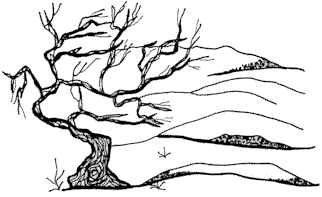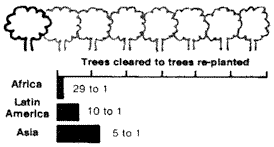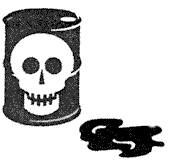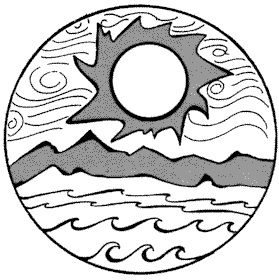| Advance of the Deserts |Disappearing of Forests
| Industrialization of Agriculture
| Poisoning the
Water | The Water Crisis
Off-page links
Worldwide Population / Environment Assessment
 |
We have not inherited the earth from our parents.
We are
borrowing it from our children.
Lester Brown
|
Advance of the Deserts (Desertification)
- 1/3 of the world's people live in countries where cropland is shrinking.
(1/3 of US cropland is now undergoing a marked decline in long-term productivity because
of soil erosion.)
- Desertification is a human-made problem :
over-cultivation, improper irrigation, over-grazing and poor irrigation techniques all
contribute to desertification.
GAIA: An Atlas of Planet Management*
- United Nations estimates are that 135 million people are severely
affected by desertification; 850 million people are somewhat affected.
- Estimated global losses in productivity from
desertification and soil losses are $26 billion annually; thus adequate global
conservation programs (at a total cost of $20 billion) would pay for themselves within
five years.
Toward Organic Security
- Were lost lands to continue to support agriculture, their output could be
worth at least $20 billion a year.
GAIA
Disappearing of Forests
- The world's forests help to determine global
temperature. Rainfall and other climatic conditions. Forests are providers and protectors,
they maintain ecological diversity , and protect soil from erosion.
- In 1950, 30% of the earth's land was covered by forest, half of which, or
15 % was tropical forest. By 1975, tropical forest areas had declined to 12%; by 2000, it
is expected that less than 7% of the land will be covered by tropical forest.
- Tropical forests help to stabilize the world's
climate by absorbing solar radiation. Without stable climatic conditions, crop production
is lowered.
- Climate changes could carry a global price tag of $200 billion for
irrigation adjustments alone.
GAIA
 |
The world's forest resource is quickly being
depleted by lumber companies - or by those trying to keeping warm or cook their food. The
problem is particularly severe in the Third World where much more forest land is being
cleared than planted.
New Internationalist
|
Industrialization of Agriculture The US is the largest export of food; it depends
heavily upon oil in its agriculture. Beyond Oil
Between 1950 and 1985 the global farm tractor fleet quadrupled , the
world irrigated area tripled and fertilizer use increased nine fold. The total
agricultural use of energy has multiplied sevenfold. State of the World 1987
The industrialization of agriculture has led to
much soil erosion, loss of organic matter, sinking water tables, pollution, and soil
compaction.
- The US will be virtually out of oil by 2020.
- The US may be unable to export food beyond the year 2000. Beyond Oil
The expansion of technological know-how enables us to use and misuse
ever greater stocks of natural resources - even to use them up. GAIA
Poisoning the Water Today much of our water is contaminated. Most contaminants become more
concentrated and dangerous as they move up the food chain. For example, 1/50 of a part per
million of a chemical insecticide in lake water becomes 1,600 parts per million in
fish-eating birds. Water pollution sources: Domestic sewage is dumped into lagoons, onto land, into rivers and into
the sea, In Canada 270 chemical pollutants pass through Ontario sewage treatment plants
into Lake Ontario. Toxic chemicals are sprayed on farms, fields and forests, They run off
into streams and lakes and seep through the soil into groundwater. Industrial wastes include synthetic chemicals and heavy metals that are
poured into rivers and lakes and dumped into landfill sites such as Love Canal near
Niagara Falls, New York. There are thousands of toxic landfill sites across the industrial
world . It is impossible to estimate how many are leaking into ground or surface water.
 |
Oil and chemical spills
such as the highly-publicized spill of
toxic chemicals into the Rhine river in 1986 or the Torrey Canyon oil spill into the
Atlantic in 1967 are just the tip of the iceberg.
Radioactive particles are part of the waste-stream of reactors and some
hospitals, and are a contributing factor to human cancers. |
Toxins in drinking water A worldwide survey of drinking water found among the 1,600 chemicals
detected:
| Recognized carcinogens (cause cancer) |
22 |
| Suspected carcinogens |
42 |
| Tumor promoter,/co-carcinogens |
27 |
| Recognized mutagens (cause birth defects) |
50 |
| Suspected mutagens |
15 |
The Water Crisis
 |
- 25 million people die each year in developing countries because of water
pollution - 3/5ths of them children.
- Of 80,000 square kilometers of US estuarine waters,
1/3 is now closed to shell fishing because of habitat disruption.
Toward Organic Security
- Over -fishing has destroyed much of the world's fish stock . For example
the haddock catch in the Northwest Atlantic fell from 250,000 tons in 1065 to 20,000 tons
in 1974.
GAIA
- Since 1970 , the world fish catch per person has
fallen 13%
Toward Organic Security
|
- 83% of all marine pollution is derived from land based activities. Some
200,000 tons of oil enter the ocean each year through accidental loss and seepage.
Pesticides, industrial sewage, radioactive waste and the dumping of marine pollution.
GAIA
- Use of groundwater in the IS alone outstrips
replacement rates by 21 billion gallons a day
Beyond Oil
Title graphic: Sr. Eunice Cudzewicz, Medical Mission Sisters Produced by the Office on Global Education, National Council of Churches, 2115 N. Charles
St., Baltimore, MD 21218-5755
A program of the Divisions of Education and Ministry, and Church World Service
SOURCES:
- Beyond Oil: The threat to Food & Fuel in the Coming Decades, A
Summary Report, November 1986: Carrying Capacity, Inc., 1325 G Street, NW, Suite 1003,
Washington, D.C. 10005.
- CREATION, P. O. Box 19216, Oakland CA 94619
- Environment, published eight times annually by Heldref Publications, 4000
Albermarle St., NW, Washington DC 20016.
- GAIA: An Atlas of Planet Management, Dr. Norman Myers, General Editor,
Anchor Books, Anchor press/Doubleday Company Inc., Garden City NY, 1984.
- National Wildlife Magazine, which annually addresses the state of the
earth (see the February/March issue) National Wildlife Federation. 1412 16th Street, NW,
Washington D.C. 20036.
- State of the World 1987, Lester R. Brown et at, Worldwatch Institute,
1776 Massachusetts Avenue, NW, Washington , D.C. 20036.
- The New Internationalist , No. 171, May 1987 new Internationalist
Publications, Ltd. 175 Carlton St., Toronto, Ontario M5A 2K3; for subscription enquiries:
P.O. Box 1143 Lewiston, NY 14092.
- Toward Organic Security: Environmental Restoration or the
Arms Race? Peace & Environment Platform Project, c/o World Citizens
Assembly, Suite 506 Sutter St., Sam Francisco, CA 94018.
|